We interrupt this regular broadcast of academic paper summaries to bring you these science messages from the New Horizons probe…
February 1930, the Lowell Observatory, Arizona, USA. A 23-year-old Clyde Tombaugh is poring over multiple photographic plates examining them for anything that moves. He’s been doing this for nearly a year, searching for the long theorised ‘Planet X’ that’s perturbing Uranus’s orbit. At long last, he finds something and the discovery is announced to the world in March 1930. 85 years later and NASA’s New Horizons probe has finally given us a close up view of this alien world.
Trending across the globe with the hashtag #PlutoFlyBy, the New Horizons probe this week came within 7,700 miles (12,500 km) in a fleeting drive-by of the Pluto system. Launched in January 2006, when Pluto was still classified as a planet (it was downgraded to dwarf planet in August 2006 by the International Astronomical Union and people were not happy), it finally arrived, after a 9 year journey, at the edge of the Solar System.
Here’s what we thought Pluto looked like before:
For twelve years this was our sharpest view of the surface of Pluto: an oddly coloured, ugly blobish mess. No wonder it never got much love. The discovery of Charon in 1978 allowed us to measure the mass of Pluto. Spectral observations from Earth told us that it had a thin atmosphere of nitrogen, methane and carbon monoxide. We also discovered some more pretty small moons (Pluto has 5 in total: Charon, Nix, Styx, Hydra and Kerberos), but we didn’t know much else about this tiny alien world.
New Horizons has turned this fuzzy blob and its moons into real imaginable worlds with features & craters, over the course of just a couple of days:

Pluto and Charon get clearer as New Horizons approaches from July 8th-11th 2015. Images from NASA / JHUAPL / SwRI / Emily Lakdawalla.
As it got closer, the other instruments on New Horizons such as its spectrograph, also took measurements and we started to get some science! We found out that Pluto was slightly bigger than we previously thought (by about 80km) meaning that it was therefore less dense than we thought. That means more ice than rock must be present on Pluto, a conclusion that is backed up by the observation that the polar caps on Pluto seem to be made of nitrogen and methane ice. This thought excited a lot of planetary scientists. It also meant that it hopped over Eris to become the biggest dwarf planet of them all, but still just a bit smaller than our own Moon.
The probe also detected Pluto’s atmosphere, a really rare opportunity because it’s so cold out there. At such a large distance from the Sun, the gases tend to freeze to the surface. In 1989 though, Pluto was at its closest point to the Sun, which warmed the atmosphere up enough for it to stick around until now. Which, if we’d waited any longer to send a probe, we wouldn’t have seen.
The weird result, though, was that some of this nitrogen gas was seen to be coming off the surface of the Pluto. This sparked a lot of discussions between scientists, who were at least thankful for something to do whilst they waited for the moment of closest approach. A moment that would be fraught with worry due to the perilous nature of the Pluto system. A collision with a a dust particle the size of a grain of rice could spell disaster for the probe and render it incapable of communicating with Earth.
So, hours before the closest approach, the probe took a high resolution image of Pluto and beamed it back to Earth. When the download came through the whole world was rewarded with this stunning image of an alien world finally come into focus:

Pluto, as imaged by the LORRI instrument on board New Horizons just hours before its closet approach. Image from NASA.
This image is over 10 times the resolution of images previously released by NASA. The first word that comes to mind is, wow. The variety in the terrain is stunning: big craters, mountains, smooth regions, dark and light patches. Now we have these images, scientists can start speculating, particularly about the most striking feature of the image, and the one that also generated the most memes that day: the smooth, bright heart feature now dubbed the Tombaugh region after our good friend Clyde (remember him from the beginning of the story?). The fact that it’s smooth suggests that it’s young; the more craters an area has, the longer it has been around, and so the more impacts it has seen. People have speculated that it may even have been made from ice settling to the surface, just like snow falling.
With that image we also got a peek at Charon, Pluto’s largest moon, which turned out to be just as excitingly baffling as Pluto itself:
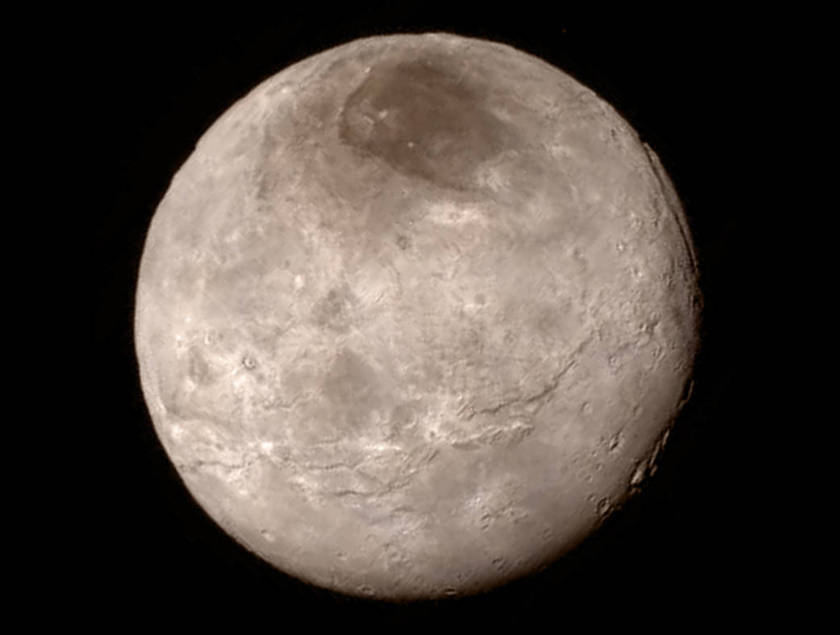
Charon, Pluto’s largest moon, imaged by New Horizons just before its closest approach. Image from NASA.
Again there are craters, but not quite as many as other moons of similar size. Saturn’s moons Dione and Tethys, for instance, are peppered with them. This unexpectedly suggests a younger surface, with more features than anticipated as well. On the upper right side of the moon, you can see a notch in the edge, which runs into a deep, scarred canyon across the surface – one that was calculated to be about 6-10 km (4-6 miles) deep! Charon’s canyon trumps Earth’s “Grand” Canyon literally by miles. Also notice that dark reddish patch up on the northern side of the moon, a region affectionately dubbed “Mordor” (from Lord of the Rings) by the mission scientists. Remember that problem of the nitrogen escaping from Pluto’s surface? Well, at the moment people think that that’s where it’s ending up; it’s settling onto Charon’s pole and being processed into a cocktail of new ices, creating an even younger surface.
As the closest approach came and went and the world anxiously waited for the probe to phone home 14 hours later, the team then released an image with false colours, to highlight which surfaces were made of different materials. And with its release, that most beloved heart of the internet was shattered into two:
Now the right side of the heart appears much older. It’s covered in craters and is made entirely of ice. Speculation was rife amongst the mission scientists and across the internet. Such is the way of science: to speculate, discuss, argue, speculate some more, and then hopefully agree to what sounds like a coherent theory.
The mission team were rewarded at around 9pm ET on Tuesday when the probe finally pinged back to say it was okay and that its hard drives were full, to much jubilation in the mission control room:

NASA’s New Horizon’s Team celebrates at Mission Control on Tuesday 13th July when the signal from the probe was received at precisely 8.52.37pm ET. Photograph: Bill Ingalls/AP
On Wednesday it rotated its antennae towards Earth and started beaming back that all-important data from the fly by. It has taken a lot though – so much so that with the 1.68 kilobits per second download speed that you get from the edge of the Solar System (compare that to modern Dial Up internet speeds of ~ 20 kilobits per second) it’s going to take months to download it all. That’s a whole lot of buffering rage for the mission team to go through.
On Wednesday, they released the first image they downloaded: this amazing image of a close up, taken a mere hour or so before its closest approach, of Pluto’s surface on the right hand side of that heart shaped Tombaugh region:
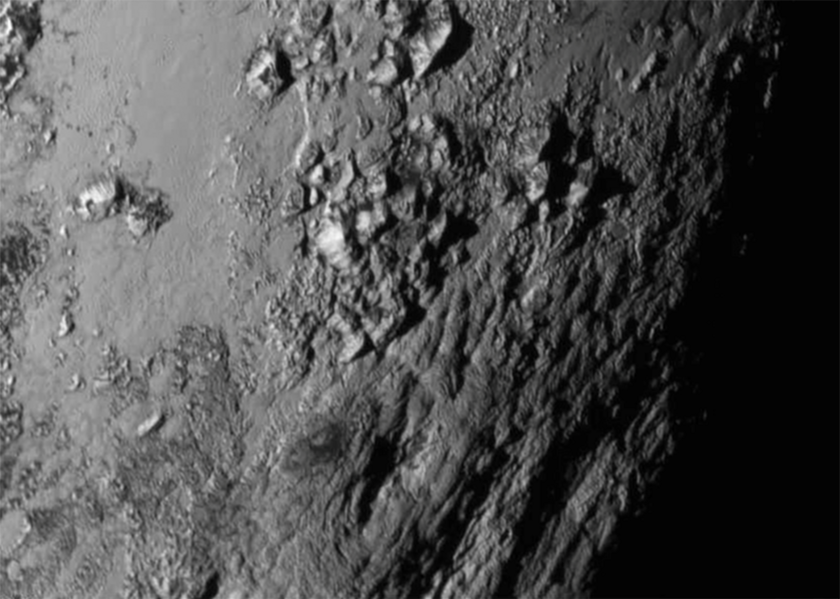
Mountains on Pluto’s surface are imaged by the LORRI instrument 1.5 hours before New Horizon’s closest approach when it was 770,000 km above the surface. Image from NASA.
This incredibly detailed image revealed mountains that were over 3,500m (11,000 ft) tall! In general, smaller planets with lower surface gravity tend to have larger mountains, but compare that to Mauna Kea, Hawaii (4,205 m, 13,795 ft) and Mont Blanc, France (4,807 m, 15,771 ft) on a planet that is only half the size of the USA in diameter. Pluto has some serious lumps and bumps.
What it doesn’t have in this region though is craters – not one has been found yet on this image, suggesting again that these mountains are incredibly young for the Solar System – only about 100 million years old. What’s more is that these mountains are thought to be made out of pure water ice. That’s right, I did say water. Your eyes do not deceive you. It’s so cold though that the ice is acting just like rock. Maybe the idea of a ski trip to Pluto isn’t such a bad one after all, if it wasn’t for the whole -240°C(-400°F) thing and the lack of friction it’d be perfect!
The one unanswered question though is how in the Universe did these mountains even form? Previously, when we’ve observed icy mountains like this on other small bodies/moons in the Solar System (like Saturn’s moon Iapetus or Jupiter’s moon Io) we’ve speculated they’ve come from tidal interactions between the small moon and the giant planet it’s orbiting. But Pluto is already the “big planet” in this system, so these mountains can’t possibly have come from such a process. It’s a puzzling question, one which has sent planetary scientists and geophysicists back to the drawing board. Perhaps the core of Pluto is radioactive, and despite being a tiny, icy planet is still capable of storing enough heat inside to power geological formations such as this? No doubt there’ll be a lot more speculation and discussion before anyone agrees on anything.
Until then, all we can do is wait. Wait for more data. Wait for more science results. And wait to be amazed once more at the wonders of human discovery.

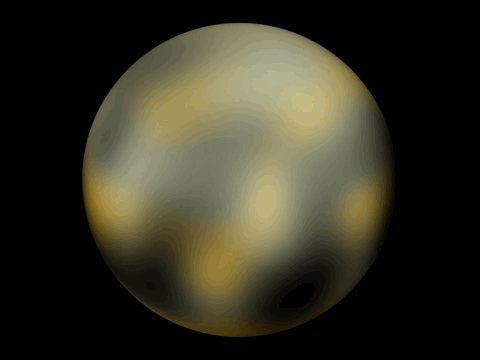

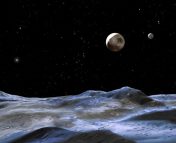


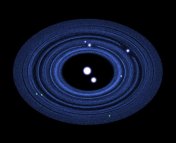
“False colour image of Pluto (left) and Chandra (right) to show surface features. Image from NASA.”
Err. “Chandra”?
Predictive text ran away with itself perhaps? I’ve had to add “Charon” to my user defined dictionary too